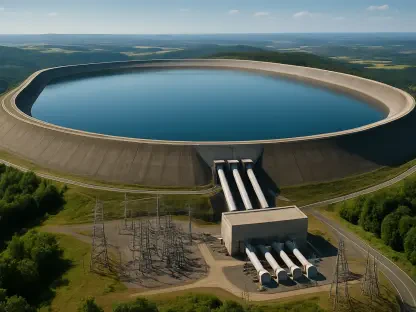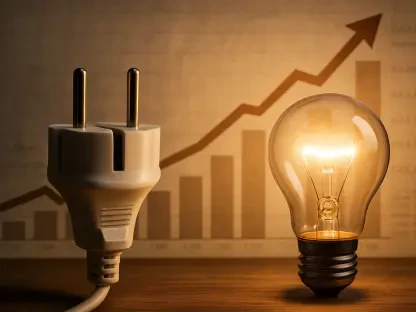In an era where renewable energy is not just a choice but a necessity, Google has embarked on an ambitious path by entering into a historic agreement with Brookfield Asset Management. This monumental collaboration, which has secured a 3,000-megawatt (MW) hydropower procurement, is slated to transform the way energy is sourced for Google’s extensive data centers around the United States. The pact, marked by the Hydro Framework Agreement (HFA), represents the largest deal of its type in world history, setting a new benchmark for corporate commitment to sustainable energy practices. Its focus primarily resides on leveraging hydropower to meet burgeoning electricity demands, especially those propelled by advancements in artificial intelligence and digital services. Given the environmental implications and the growing energy challenges faced by leading companies globally, this partnership positions Google distinctly as a pioneer in employing traditional energy resources for modern needs, coupling age-old hydroelectric technology with contemporary digital requirements.
Infrastructure Modernization Approach
Central to this substantial agreement are key projects aimed at modernizing existing infrastructure to ensure reliable and efficient energy delivery. Google’s involvement spans relicensing and upgrading efforts at Brookfield’s Holtwood and Safe Harbor hydroelectric facilities located in Pennsylvania. With a considerable financial commitment exceeding $3 billion, these upgrades will lead to a total generation capacity of 670 MW. This strategic investment emphasizes Google’s intent to utilize existing infrastructure for green energy production, addressing its massive electricity requirements while prioritizing sustainability. The Holtwood Hydroelectric Dam stands as a historical testimony, being the oldest among the primary dams on the lower Susquehanna River, originally constructed by the Pennsylvania Water & Power Company from 1905 to 1910. The dam’s renovation in 2013, through a second powerhouse, significantly boosted its generation capacity, showcasing the potential intrinsic in revamping traditional infrastructure. Similarly, the Safe Harbor Hydroelectric Project, established in 1930, underscores Brookfield’s dedication to enhancing infrastructure sustainably, aligning with Google’s strategic energy objectives.
The Growing Role of Hydroelectric Power
This endeavor spotlights the increasingly crucial role of hydropower, especially as companies transition towards clean energy solutions. Google’s engagement shines a light on the unique benefits of hydroelectric power, which remains vital as a carbon-free and cost-efficient energy source. Emerging as a reliable solution with job-creating potential, hydropower complements the corporate sustainability goals of major organizations, particularly those heavily invested in digital technologies. Amanda Peterson Corio, leading Google’s data center energy initiatives, underscores hydropower’s integral role in fortifying the electricity grid and boosting employment prospects. The consensus within the industry suggests hydropower is still relevant today, proving indispensable for clean energy supply while supporting corporate responsibility. Connor Teskey, president of Brookfield Asset Management, further highlights the pact’s significance in fulfilling hyperscale energy demands, positioning hydropower as a cornerstone for ongoing sustainable energy solutions to cater to modern digital needs.
Addressing Regional Energy Dynamics
The collaboration between Google and Brookfield spans critical regions within the Mid-Atlantic (PJM) and Mid-Continent (MISO) electricity markets, yet remains adaptable enough to extend reach into other territories across the United States as needed. Flexibility is vital, given the dynamic nature of distinct electricity markets and their renewable integration challenges. The PJM Interconnection, the largest grid in the nation, has notably faced difficulties in accommodating renewable energy due to extended queue times and spiraling costs. Google’s strategic alignment with Brookfield actively addresses these complexities, ensuring consistent clean energy supply where its operations are most concentrated. Moreover, this agreement secures ongoing energy commitments for existing consumers like Amtrak from the Safe Harbor facility, warranting seamless continuity in service through Brookfield’s transaction structure. These factors illustrate how historic infrastructure can support contemporary energy strategies while preserving ongoing regional commitments, accentuating Google’s forward-thinking approach and commitment to sustainable energy distribution.
Bridging Tradition and Technology for Future Solutions
In today’s world, where renewable energy is essential and not just an option, Google has taken a bold step by forging a landmark agreement with Brookfield Asset Management. This significant partnership secures a 3,000-megawatt (MW) hydropower supply, aimed at revolutionizing energy sourcing for Google’s numerous data centers across the United States. The deal, formalized via the Hydro Framework Agreement (HFA), sets a world record as the largest arrangement of its kind, showcasing a monumental corporate commitment to sustainable energy practices. The agreement prioritizes utilizing hydropower to fulfill the rising electricity needs, largely fueled by the progression of artificial intelligence and digital technologies. Considering the environmental challenges and ever-increasing energy demands faced by leading global enterprises, this partnership distinctly positions Google as an innovator, merging time-tested hydroelectric technology with the dynamic demands of today’s digital age.









